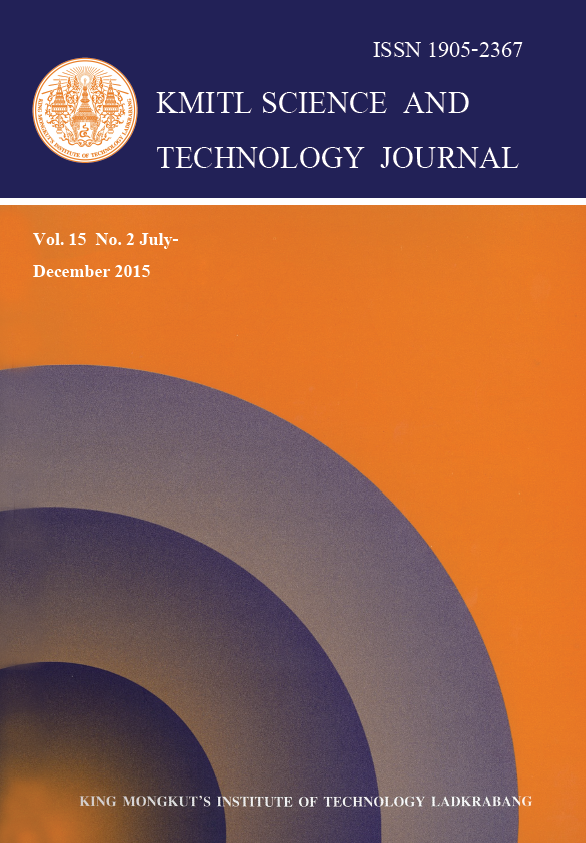Biotransformation of Insoluble Lead Compounds by Fungi Isolated from Polluted Soil
Main Article Content
Abstract
Industry, fossil fuel combustion, agriculture and mining operations are the cause of heavy metal contaminated sites and the heavy metal contamination directly affects human health. The objective of this research was to investigate the ability of fungi to solubilize and immobilize insoluble lead compounds such as lead carbonate (PbCO3) and lead oxide (Pb3O4). Soil fungi were isolated from contaminated soil in zinc mine at Tak province, Thailand. Isolated fungi were plated on PDA medium supplemented with 0.5% (w/v) of insoluble lead compounds. Aspergillus niger MS7 and Aspergillus sp.1 showed the highest activity in solubilizing insoluble lead compounds with clear zone appearance more than 40 mm. in diameters. Precipitation of lead biomineral crystals was observed in agar medium underneath colonies of A. niger MS7. The crystals were purified, and analyzed by scanning electron microscope (SEM) and X-ray powder diffraction (XRPD), and the results revealed that they were lead oxalate (PbC2O4). It is suggested that soil fungi have potential application in heavy metal bioremediation.
Keywords: Biotransformation, Bioremediation, Heavy metal, Lead compound, Fungi
*Corresponding author:
E-mail: thana5306@hotmail.com
Article Details
Copyright Transfer Statement
The copyright of this article is transferred to Current Applied Science and Technology journal with effect if and when the article is accepted for publication. The copyright transfer covers the exclusive right to reproduce and distribute the article, including reprints, translations, photographic reproductions, electronic form (offline, online) or any other reproductions of similar nature.
The author warrants that this contribution is original and that he/she has full power to make this grant. The author signs for and accepts responsibility for releasing this material on behalf of any and all co-authors.
Here is the link for download: Copyright transfer form.pdf
References
[2] Monachese, M., Burton, J.P. and Reid, G., 2012. Bioremediation and tolerance of humans to heavy metals through microbial process: a potential role for probiotics. Applied and Environmental Microbiology. 78(18), 6397-6404.
[3] Gadd, G.M., 1993. Interactions of fungi with toxic metals. New Phytologist, 124, 25-60.
[4] Gadd, G.M. and White, C., 1989. Havy metal and redionuclide accumulation and toxicity in fungi and yeast. In: Poole, R.K. and Gadd, G.M. Metal-Microb Interactions, Oxford, IRL Press, pp. 19-38.
[5] Gadd, G.M., 2000. Bioremedial potential of microbial mechanisms of metal mobilization and immobilization. Current Opinion in Biotechnology, 11, 271-279.
[6] Dutton, M.V. and Evans, C.S., 1996. Oxalate production by fungi: its role in pathogenicity and ecology in the soil environment. Cannadian Journal of Microbiology. 42, 881-895.
[7] Gadd, G.M., 1999. Fungal productions of citric and oxalic acid: importance in metal speciation, physiology and biochemical process. Advance Microbial Physiology, 41, 47-92.
[8] Wei, Z., Hillier, S. and Gadd, G.M., 2012. Biotransformation of manganese oxide by fungi: solubilization and production of manganese oxalate biominerals. Environmental Microbiology, 14, 1744-1752.
[9] Singh, H., 2006. Mycoremediation: fungal bioremediation. New Jersey, Wiley-Inter Science.
[10] Sayer, J.A., Raggett, S.L. and Gadd, G.M., 1995. Solubilization of insoluble metal compounds by soil fungi: development of a screening method for solubilizing ability and metal tolerance. Mycological Research, 99(8), 987-993.
[11] Von Arx, J.A., 1970. The genera of fungi sporulating in pure culture. Vaduz, AR Gantner Verlag KG.
[12] Barnett, H.L. and Hunter, B.B., 1998. Illustrated genera of imperfect fungi. 4th ed. Minnesota, APS press.
[13] Fomina, M.A., Alexander, I.J., Colpaert, J.V. and Gadd, G.M., 2005. Solubilization of toxic metal minerals and metal tolerance of mycorrhizal fungi. Soil Biology Biochemistry. 37, 851-866.
[14] Martino, E., Perotto, S., Parsons, R. and Gadd, G.M., 2003. Solubilization of insoluble inorganic zinc compounds by ericoid mycorrhizal fungi derived from heavy metal polluted sites. Soil Biology Biochemistry, 35, 133-141.
[15] Yazdani, M., Yap, C.K., Abdullah, F. and Tan, S.G., 2010. An in vitro study on the adsorption and uptake capacity of Zn by the bioremediator Trichoderma atroviride. Environment Asia, 3, 53-59.
[16] Sayer, J.A. and Gadd, G.M., 1997. Solubilization and transformation of insoluble metal compounds to insoluble metal oxalates by Aspergillus niger. Mycological Research, 101, 653-661.
[17] Joseph, E., Cario, S., Simon, A., Worle, M., Mazzeo, R., Junier, P. and Job, D., 2012. Protection of metal artifacts with the formation of metal-oxalates complexes by Beauveria bassiana. Frontiers in Microbiology, 2, 1-8.
[18] Sutjaritvorakul, T., Gadd, G.M., Suntornvongsagul, K., Whalley, A.J.S., Roengsumran, S. and Sihanonth, P., 2013. Solubilization and transformation of insoluble zinc compounds by fungi isolated from a zinc mine. EnvironmentAsia, 6, 42-46.
[19] Gadd, G.M. and Griffiths A.J., 1978. Microorganisms and heavy metal toxicity. Microbial Ecology. 4, 303-317.
[20] Jentschke, G. and Godbold, D.L., 2000. Metal toxicity and ectomycorrhizas. Physiologia Plantarum. 109, 107-116.
[21] Sayer, J.A., Cotter-Howells, J.D., Watson, C., Hillier, S. and Gadd, G.M., 1999. Lead mineral transformation by fungi. Current Biology, 9, 691-694.
[22] Jacobs, H., Boswell, G.P., Happer, F.A., Ritz, K., Davidson, F.A. and Gadd, G.M., 2002. Solubilization of metal phosphate by Rhizoctonia solani. Mycological Research,106, 1468-1479.
[23] Adeyemi, A.O., 2009. Biological immobilization of lead sulphide by Aspergillus niger and serpula himantioides. International Journal of Environmental Research, 3(4), 477-482.
[24] Peberdy, J.F. Fungal cell walls. In: Kuhn, P. J., Trinci, A.P.J., Jung, M.J., Goosey, M.W. and Copping, L.E., 1990. Biochemistry of Cell Walls and Membrane in Fungi. Berlin, Springer-Verlag, pp.5-30.
[25] Tobin, J.M., Cooper, D.G. and Neufeld, R.J., 1990. Investigation of the mechanism of metal uptake by denatured Rhizopus arrhizus biomass. Enzyme and Microbial Technology, 12, 591-595.


